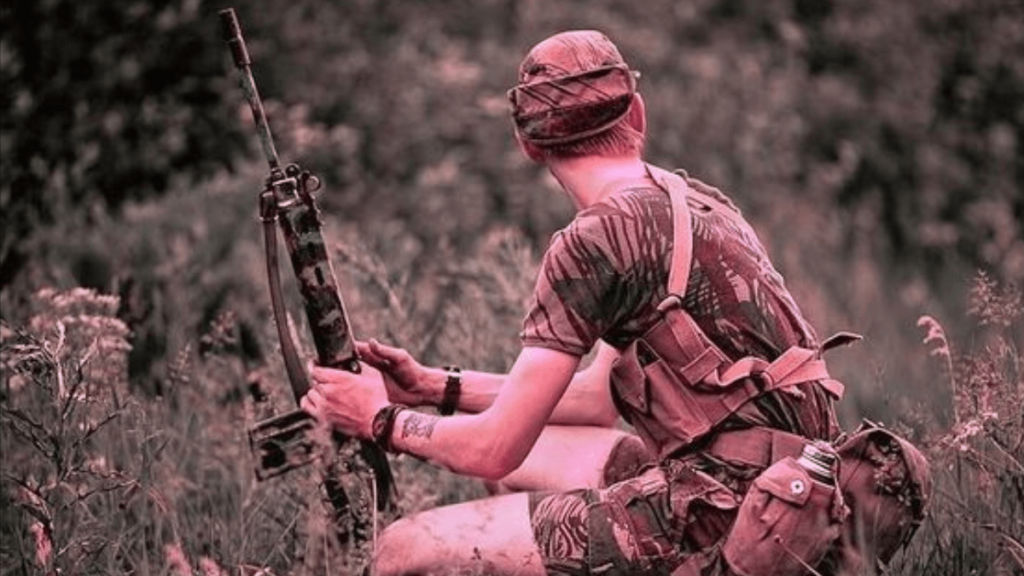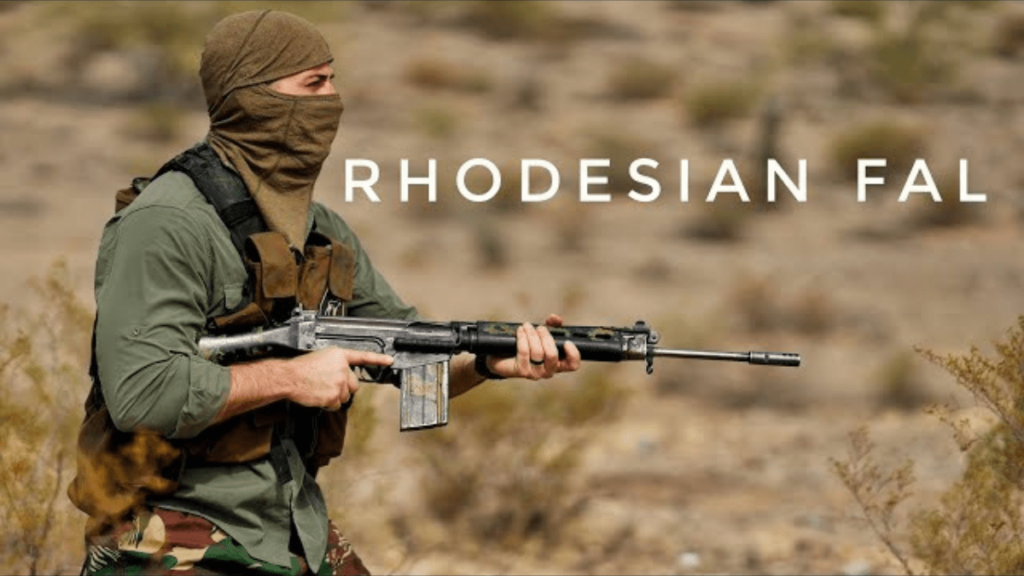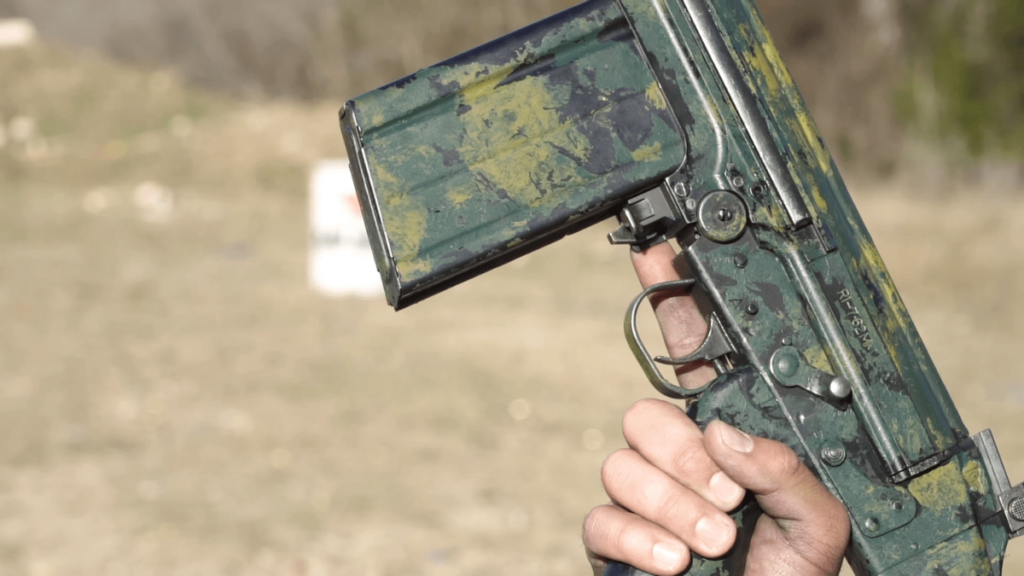Regarding the Rhodesian Bush Wars, there are two aesthetic things associated with it: the brushstroke camo and the Rhodesian FN FAL.
The FN FAL, which was short for Fabrique Nationale d’Herstal Fusil Automatique Léger, was the standard service rifle of the Rhodesian Armed Forces throughout the Bush Wars.
This Belgian rifle was a hard-wearing workhorse that packed a merciless punch. Simple to use, accurate, and well-built, it was a trusted tool of the Rhodesians in their doomed war.
In the years after the Bush Wars, the Rhodesian FN FAL has earned somewhat of a legendary status amongst gun collectors for both their aesthetic and unique military history.
“During a particularly intense firefight with enemy fights, a Rhodesian troopie was blinded when a brass casing ejected, bounced off his partially extended carry handle, and hit him in the eye.”
Naturally, this means they’re a serious prize for any gun enthusiast. Compared to a generic FN FAL, a field-used Rhodesian variant can fetch high prices, particularly if they feature the original Rhodesian camo scheme affectionately known as “baby poop”.
Of course, to cater to the demand, there’s a serious number of fake Rhodesian FN FALs on the market.
But fear not; in this article, we’ll cover the fascinating story behind this iconic weapon before teaching you how to identify an original Rhodie weapon properly.
So, don your brushstroke, mukkas, and let’s get started!
Rhodesian Bush War fact: The aesthetic and instantly recognizable “baby poop” camouflage scheme many Rhodesian troops applied to their weapons in the field was surplus aviation paint used by the Rhodesian Air Force.
The Rocky Story of the Rhodesian FN FAL
Rhodesia became an independent state in 1965. However, its establishment was unpopular in the West, especially in Great Britain.
Like any independent country, they needed an army and modern weapons superior to the country’s inherited rifles.
However, Rhodesia was under a series of sanctions, making acquiring guns difficult. Undeterred, the nation pursued some unorthodox methods to get its hands on weapons.

Rhodesia was keen to take anything they could get. Their arsenal soon featured a wide range of second-hand weapons from both Western countries and across the Eastern Bloc. Such as:
- Surplus G1 rifles formerly belonging to the German Bundeswehr obtained via Portugal
- South African-made R1s
- L1A1s from Britain and Australia.
But what makes them different? Let’s look at some of the simplest ways to identify a Rhodesian FN FAL correctly.
How To Identify a Rhodesian FN FAL
As soon as the weapons arrived in Rhodesia, the FN FALS were promptly stamped with domestic serial numbers via electro-stenciling.

The chosen prefix that designated the rifle as being in the service of the Rhodesian military was “RA” in one of the following parts of the weapon:
- The bolt.
- Bolt carrier
- The upper receiver
- The lower receiver.
An interesting thing to note about Rhodesian FN FALs is the process that the original factory stamps on the imported South African R1 rifles underwent.
South Africa wasn’t supposed to be arming the unrecognized nation. If a factory-fresh South African R1 fell into the hands of the enemy (detail), they could use it as evidence to show the UN that South Africa was supplying new firearms to the country.
The original South African factory stamp that sat on both the R1 and its magazines was an M sitting inside a U. The Rhodesians lightly drilled and sanded the stamp out, leaving a scratched or dimple-like feature where the stamp once was.
In some rare cases, the South African factory stamp was in an awkward location on the weapon and was left untouched. However, these are rare.
It’s worth noting that ex-German Army G1s and FALs made in Belgium didn’t undergo this process as they were second-hand and heavily used, so it was difficult to trace them back to wherever they came from.
Following the end of the Bush Wars and the demise of Rhodesia, many FN FALs were initially used to arm the newly formed military of Zimbabwe under Robert Mugabe.
Instead of the old “RA” stamp, the new FN FALs of Zimbabwe were marked as “ZA” and then painted brown rather than the original “baby poop” camo. Speaking of which!
Rhodesian Baby Poop Camo!
One main element that sets a Rhodesian FN FAL apart from the rest is its aesthetic and instantly recognizable camouflage pattern.
But most people don’t know that the “baby poop” camo only came into the Bush Wars later. Initially, the Rhodesian FN FAL looked dramatically different.
At the start of the Bush Wars, Rhodesian troops coated their FN FALs in black enamel paint. But this had dire consequences when operating against guerrilla fights in the African bush.

After capturing an enemy fighter during a Fireforce Operation, Rhodesians were informed that their jet-black rifles against their brushstroke camo uniforms silhouetted them and made them an easy target.
To deal with this, the Rhodesian troops utilized surplus aviation paint leftover from the Rhodesian Air Force and began applying it to their rifles which quickly resembled, yep, you guessed it! A baby’s poop!
Not only did it work in breaking up their outline on field operations, but it also became a uniquely iconic feature of the Bush Wars.
Other Modifications Commonly Made to The Rhodie Service Rifle
When dealing with Rhodesian FN FALs, you should be aware of a few other common field modifications.
Amongst the rank-and-file troops of the Rhodesian military, it was common for the weapon’s carry handle and rear sling swivel to be removed for the following reasons:
- During a particularly intense firefight with enemy fights, a Rhodesian troopie was blinded when a brass casing ejected, bounced off his partially extended carry handle, and hit him in the eye.
- When operating in the thick and inhospitable African bush, some Rhodie troopies found their slings would often catch on branches and thick foliage, so they opted to remove them.
Of course, these are some modifications that you can expect to find. But not every Rhodesian soldier carried them out and opted to keep their slings and carry handles.
For example, retaining both the sling and carry handle was common amongst Rhodesian special forces units (Rhodesian Special Air Service, Selous Scouts, Grey’s Scouts, etc.).
Rhodesian special forces fact! Specialist units would often attach a WW2-era British Bren sling to their FN FAL as it was longer than the standard issue FAL sling,
Where Can You Find a Rhodesian FAL?
And now, for the bit you’ve undoubtedly been waiting for, where do you find an original Rhodie FN FAL? Let me tell you!
If you want to build a Rhodesian FN FAL yourself (provided you’re legally permitted to do so in your country), then you can find parts kits online or through reputable businesses.
But there’s a problem. If you think you’re the only person with love for these iconic weapons, you’re wrong. Demand for Rhodesian FN FALs is strong, so parts are highly sought after and expensive!
An alternative is to keep a key eye on the likes of sites like Gunbroker and know what you’re looking for.
Further Reading
- Egyptian AK 47: Meet The Iconic Maadi AKM!
- The Bulgarian AK-47: The Best Kalash Outside Of Russia?
- AR15 vs M16: What Are The Most Important Differences?
Sometimes, you can get lucky and find Rhodie kit with the original “RA” stamps mistakenly described as “South African”.
Many often describe the difficulty of obtaining or building a true Rhodesian FAL as being far more difficult than an AR-15 but simpler than building an original Kalashnikov.
If you want to truly own a piece of history from the long-gone nation of Rhodesia and the notorious Bush War conflict, then budget at least $2,000.

